Dhanurasana Yoga (Bow Pose) – How To Do Steps And Its Benefits
In this day and age, when even twenty four hours a day seems less, our health takes a beating. We often fall sick, have ailments and sometimes lose the zest for living too. Blame it on the rigmarole of living rat raced lives or the technical ways of being, we are the only ones to be blamed for such maladies.
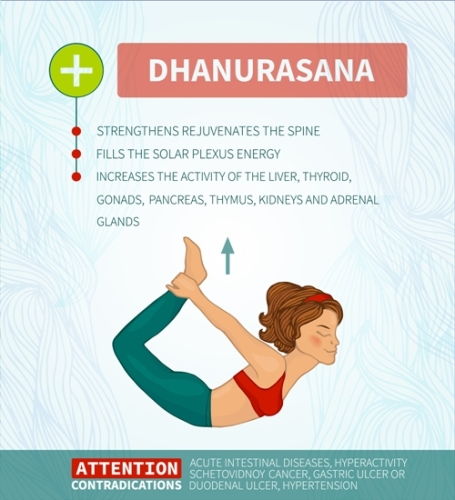
However, all hope is not lost. Thanks to the art and science of yoga, we now can bring back vitality and vigour. There are many asanas which time and again have proved to be beneficial. Today we would like to speak more about dhanurasana yoga (Bow Pose). Hence, please read on and be well-informed for the same.
Steps To Do Dhanurasana Yoga (Bow Pose),Tips And Benefits:
Simple Steps Of Bow Pose:
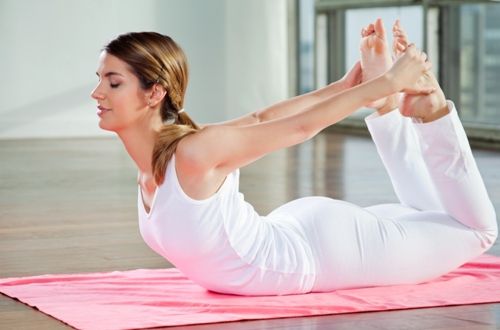
1. Begin by lying down on your belly with hands on either side of your torso, with palms facing upwards.
2. Now while exhaling, bend your knees and bring your heels as close to your buttocks as possible.
3. From this position try to take hold of your ankles by reaching out your hands. Do not try to grasp the top of the feet.
4. While doing so, ensure that the knees do not widen more than the width of your hips. Maintain them at hip width throughout the whole pose.
5. Inhaling strongly, take your heels away from the buttocks also ensuring that the thighs are lifted off the floor.
6. This would necessitate you to lift your upper torso and head off the floor.
7. Keep your back muscles soft and keep your tailbone burrowed down to the floor.
8. Now, with your heels and thighs lifted up higher, force the shoulder blades very firmly against your back. This would hence result in opening the heart.
9. Also, the top of your shoulders would be pulled away from your ears. While in this position, gaze forward.
10. Although breathing might be difficult in this pose, with the belly pressed to the floor, breathe as much as you can into the back of your torso.
11. Remain in this position for 20 to 30 seconds. Then slowly go back to the original position, lying quietly for a few breaths. Repeat the pose once again once or twice to benefit better.
Dhanurasana Yoga Tips For Starters:
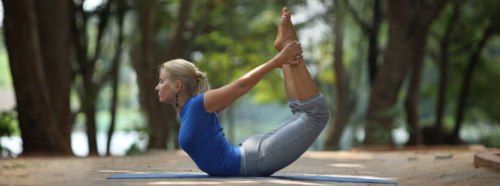
You may use a strap to wrap the front of your ankles, if it is difficult to hold the ankles directly. While doing so, hold the free ends of the strap, with the arms fully extended. You may also experience difficulty lifting your thighs from the floor. You can use a rolled up blanket to support your thighs to give you an upward boost.
Preparatory And Follow-Up Poses For Bow Pose:
Some of the poses that would prepare you to perform dhanurasana are bhujangasana, virasana, sputa vriksasana. The poses which you can follow up for this pose are: matsyasana, urdhva dhanurasana, urdhva mukha svanasana.
Partner To The Rescue In Dhanurasana:
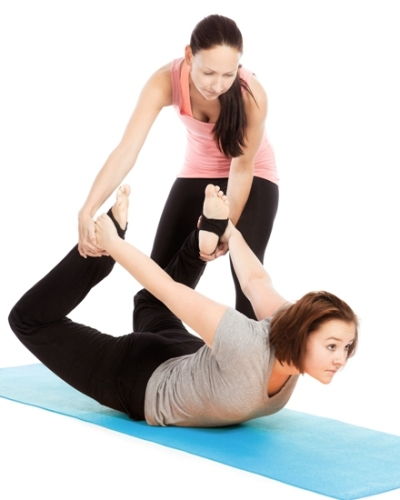
It is not necessary that you perform dhanurasana on your own. You can also team up with a friend or a yoga enthusiast for double the fun. When you enlist the help of a partner, you will be able to prepare well for when actually attempting to perform dhanurasana. You will need to first lie on your thighs and give your legs a boost slowly to avoid injuries or sprains. If you have trouble propping yourself up, ask your partner to give you a helping hand. Sometimes, when you have someone to prop you up, you may get the extra push required to follow through with the position. If you learn to master the pose, dhanurasana benefits are plenty.
You can ask your partner to kneel behind you, on the floor. Your partner will be able to support you by using his or her knees to prop up your outer knees. This should be followed by you inhaling and then lifting your upper torso off the floor by moving your heels away from the rear. However, ensure that your thighs are on the floor as support. Your partner will need to help you out with the next part of the exercise – taking hold of the back of your ankles. The partner should ensure that he or she firmly supports the ankles to allow you to be as flexible as possible.
When you have the support of your partner, you will be able to balance your torso properly. However, ensure that your partner does not pull you further into the pose. Do not exert yourself to prove a point to yourself. Only when you are ready should you lift yourself up. Your partner is there for support. However, you will be required to do all the hard work. If at first you find the bow pose difficult, ask your partner to give you a little extra support. When you come to terms with the demands of the pose, work into it slowly. There is always scope for mastering the pose when you have the support of a partner. If your partner needs to try the pose, offer assistance.
See More: All Yoga Asanas
Modifications For Bow Pose:
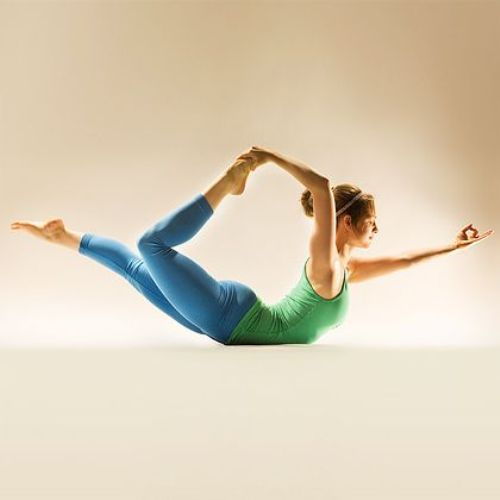
1. The knees must be very comfortable while doing this pose. In case, you happen to experience discomfort or pain, ensure that the feet are strongly flexed and knees don’t deviate outside the hip width.
2. Sometimes you may feel a pinch in the lower back. In that case, go back to original and start over by stressing on the elongation of the spine. If there is still pain, it is better to perform a variation called one sided bow pose. The pinch maybe caused due to tight quadriceps or hip flexors.
3. Sometimes, despite your best efforts, you might not always succeed at mastering the bow pose. However, all hope is not lost as there is a variation to the pose, known as Parsva (parsva = flank) Dhanurasana. You have to perform dhanurasana according the instructions which have already been given. However, the change comes when you are expected to dip your right shoulder directed at the floor with an exhalation. Your left foot will need to be tugged to the right with a strong effort. This will be followed by you rolling onto the right side of your body.
Be warned, it is not a cakewalk. In fact, a number of students have a difficult time rolling onto the side on the first attempt. The benefits of dhanurasana, and its variations, do not come easy. Never give up. You can always practice rolling onto your side without acting catching hold of your ankles. All you need to do is bend your knees and use the support of your hands to get the rolling movement right. Stay on the right side for 20 to 30 seconds, before exhaling. Roll on your belly to the left. Stay on the left side for the same amount of time before rolling back onto the belly and exhaling. You will benefit from this variation -Parsva Dhanurasana. It will give your abdominal organs a soothing massage. Aren’t you glad you tried out something new?
See More: Benefits Of Lotus Pose
Simple Steps To Perform One Sided Bow, Also Known As Parsva Dhanurasana:
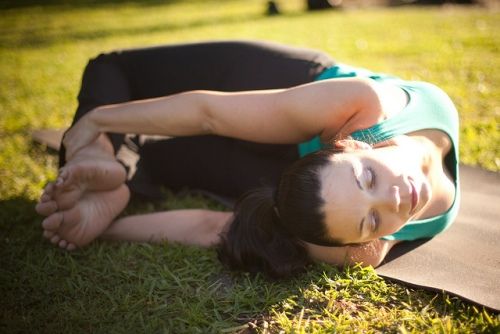
- Begin similarly by lying on your stomach, but with your left elbow in front of you. Rest your forearm on the mat with palm facing down. The right arm should be on your side, palm facing up
- Roll your shoulders, also moving your shoulder blades, to your back. Touch the mat with the top part of your left foot so that all your toes touch the earth.
- Now only bend your right knee and grasp the ankle with your right hand, maintaining to keep knee in line with the hip
- Inhale while lengthening the spine and gently force the foot back into your hand. This would make your torso lift lightly.
- Breathe and stay in this pose for 20 seconds. Go back to original and repeat the same with the other side.
Benefits Of Dhanurasana Yoga:
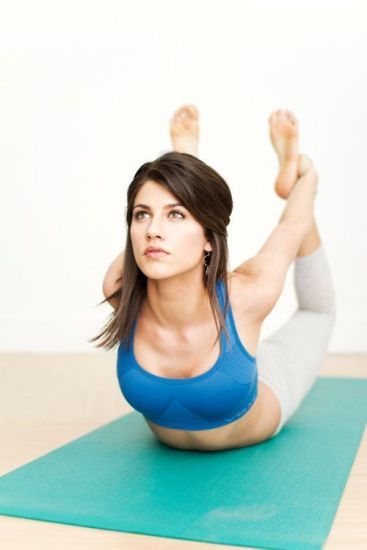
The term “dhanura” means bow in Sanskrit. Hence, dhanurasana is also known as Bow pose. The person who performs this pose looks very similar to an archer’s bow – the torso and the legs being the body of the bow, and the arms as the string. It is also sometimes known as Urdva Chakrasana, meaning upward wheel pose.
Physical Benefits Of Dhanurasana:
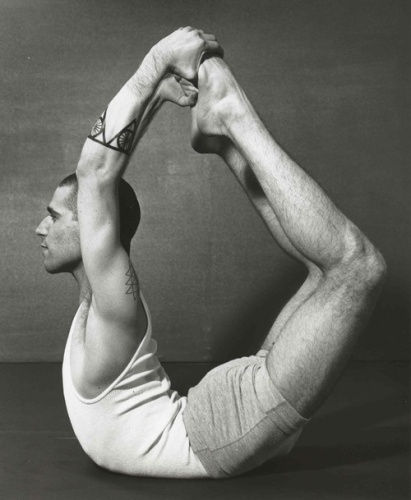
1. The pose helps to expand to the chests and the shoulders
2. It stretches almost all parts of the front body, like the ankles, thighs, groins, throat, abdomen, chest, front shins, to name a few.
3. It helps to mobilize the spine.
4. It strengthens various parts of the body like:
- Gluteus muscles of the hip.
- Hamstrings at the back of the thigh.
- Lower back musculature.
5. It stimulates and also tones the abdominal organs and organs of the neck.
See More: Bhujangasana Benefits
Therapeutic Benefits Of Bow Pose:
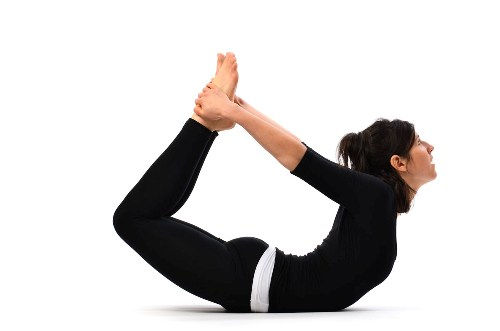
This asana is best suited for people with following conditions:
- Asthma
- Respiratory conditions
- Anxiety, fatigue and stress
- Backaches of mild forms
- Menstrual problems
Precautions For Dhanurasana:
1. This pose is not advisable for people who have previously had shoulder dislocations or shoulder impingement
2. Those with neck discomfort must refrain from performing this pose.
3. If you have previously had serious lower back injury, this pose must not be performed.
4. People suffering from insomnia and migraine must not perform this pose.
5. It is better to avoid this pose, if you suffer from Sacroiliac joint irritation.
A yoga class for advanced learners should include the dhanurasana pose. However, if you have never attempted the pose, consult a teacher before you undertake the challenge. With the right technique, this pose can be mastered in no time.
05.07.2023 @ 02:55
Great blog post. What I would like to bring about is that personal computer memory is required to be purchased but if your computer is unable to cope with what you do with it. One can install two RAM memory boards with 1GB each, as an illustration, but not certainly one of 1GB and one with 2GB. One should check the company’s documentation for own PC to make sure what type of memory is necessary.
08.07.2023 @ 15:12
Dhanurasana Yoga (Bow Pose) – How To Do Steps And Its Benefits | Recruit2network 2023
[url=http://www.gb8zy2352i65fb7yh041txf41au2vu97s.org/]uxkxspzgtsx[/url]
xkxspzgtsx http://www.gb8zy2352i65fb7yh041txf41au2vu97s.org/
axkxspzgtsx
28.06.2024 @ 11:48
Insightful read! I found your perspective very engaging. For more information, visit: READ MORE. Eager to see what others have to say!